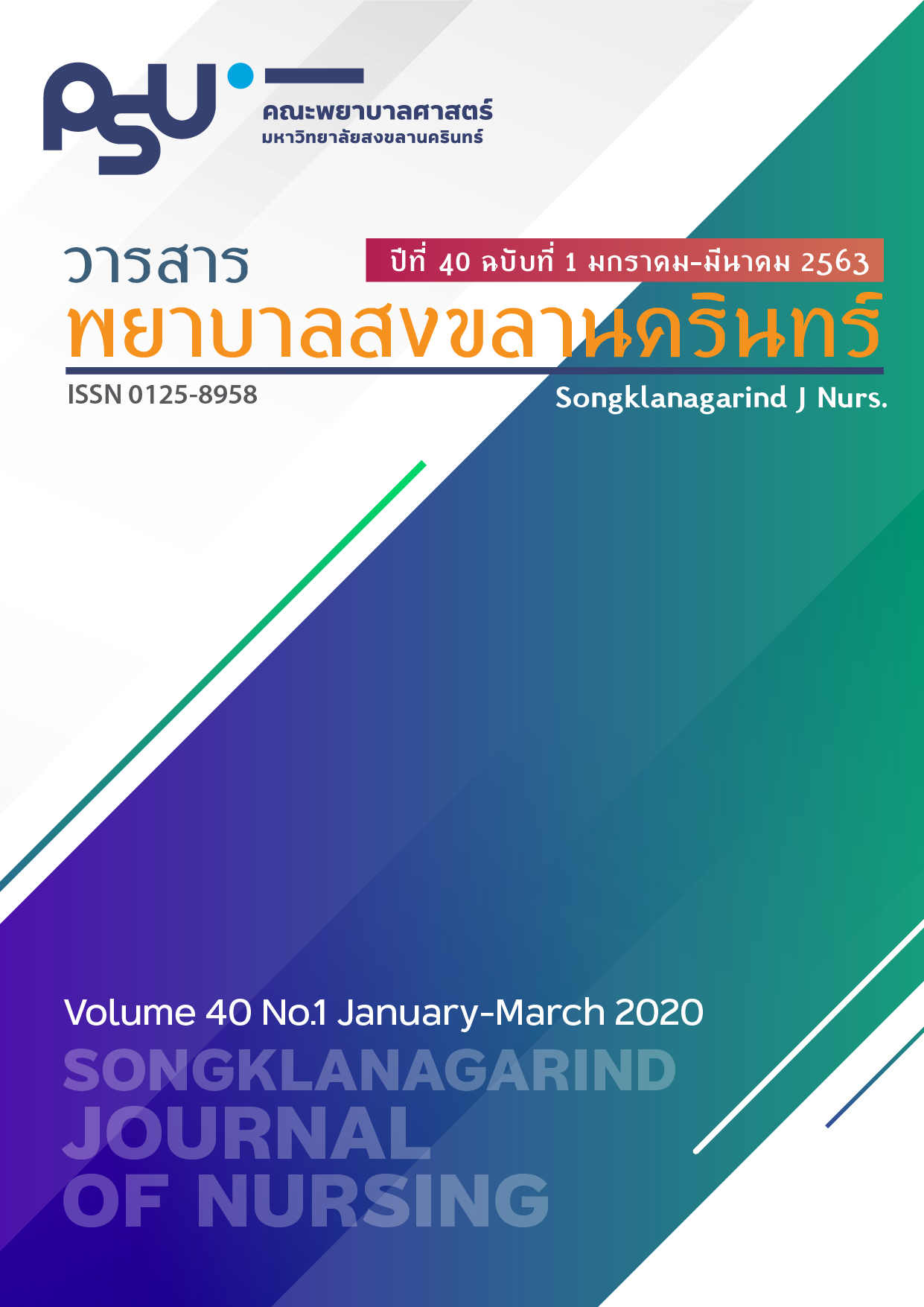Relationship Between Symptom Experiences, Symptom Management, and Stroke Severity of Patients with Acute Ischemic Stroke
Main Article Content
Abstract
This research study aimed to investigate the relationship between symptom experiences, symptom management, and stroke severity based on the concept of symptom management model. The sample included 125 patients with acute ischemic stroke, who were admitted in hospital and received stroke fast tract management within 4.5 hours. The set of instruments comprised (1) the Demographic Data Sheet, (2) the Acute Ischemic Stroke Symptom Experiences Questionnaire, (3) the Acute Ischemic Stroke Symptom Management Questionnaire, and (4) the National Institutes of Health Stroke Scale [NIHSS], which were validated by experts. Test-retest was applied to evaluate the reliability of the Acute Ischemic Stroke Symptom Experiences Questionnaire, and yielded a percentage agreement of .95. The reliability of the Acute Ischemic Stroke Symptom Management Questionnaire was examined and yielded Kuder-Richardson (KR-20) of 0.72. The inter-rater reliability of the NIHSS was .98. The data were analyzed using Pearson Product Moment Correlation, and Spearman Rank Correlation.
The results showed that the mean score of total symptom experiences was at a moderate level (M = 0.40, SD = 0.17). The mean score of total symptom management was at a moderate level (M = 0.66, SD = 0.33). The mean score of initial stroke severity was at a moderate level (M = 7.8, SD = 4.7) and the median of stroke severity after 24 hours was at a low level (Mdn = 2.00, IQR = 5.00). There were significant positive correlations between both the symptom experiences and the symptom management and the initial stroke severity (r = .217, p < .05; r = .384, p < .05, respectively). There were significant positive correlations between both the symptom management and the initial stroke severity and the stroke severity 24
hours after treatment (r = .478, p < .05; r = .355, p < .01, respectively). The findings were benefits for nurses in improving service system for patients to receive better care and access as quickly and safety as possible.
Article Details
References
2. Jauch EC, Saver J, Adams H, et al. Guidelines for the early management of patients with acute ischemic stroke: A guideline for healthcare professionals from the American Heart Association/American Stroke Association. Stroke. 2013; 44(3): 870–7.
3. Prabhakaran S, Ruffi I, Bernstein RA. Acute stroke intervention: A systematic review. JAMA. 2015; 313(14): 1451-62. doi: 10.1001/jama.2015.3058.
4. Somhanwong P, Binhosen V, Pakdevong N. Situation of care management in persons with stroke at emergency department, Bumrungrad International Hospital. J Nur Assoc Thailand, NE. 2012; 30(2): 73-81.Thai.
5. Poaremath J, Udol K, Nilanont Y, et al. Effect of emergency medical services (EMS) utilization on pretreatment time, rate of thrombolytic therapy and 3-month clinical outcomes in acute ischemic stroke patients. Oral session presented at: The 15th Graduate Research Conferences. 2014 March 28; Khon Kaen. Thai.
6. Chanagarn M, Phutthikhamin N. Perceptions on stroke risk factors warning signs treatment and preventive behaviours among health risk people. Journal of Nursing Science & Health. 2016; 39(1): 70-7. Thai.
7. Kittiboonthawal P, Yingrengreung S, Srithanya S. Perceptions of stroke warning signs among risk patients. Nursing Journal of the Ministry of Public Health. 2014; 23(3): 132-41. Thai.
8. Kamsareeruk J, Jitpanya C. Factors related to prehospital time in patients with acute ischemic stroke. JOPN. 2015; 7(2): 107-18. Thai.
9. Lekpet J, Wuthisuthimethawee P, Vasinanukorn P. Prehospital time and emergency department time for acute ischemic stroke care at Songklanagarind Hospital. Songkla Med J. 2009; 27(3): 203-12. Thai.
10. Dodd M, Janson S, Facione N, et al. Nursing theory and concept development or analysis advancing the science of symptom management. JAN. 2001; 33(5): 668-76.
11. Tainkum K. Perception of stroke warning signs among hypertensive patients and their families, Khua Mung Primary Care Unit, Amphoe Saraphi, Changwat Chiang Mai [master’s minor thesis]. [Chiang Mai]: Chiang Mai University; 2011. 68p. Thai.
12. Saeko U, Jitpanya C. A study of stroke awareness among patients at risk of stroke in Bangkok Metropolitan. Princess of Naradhiwas University Journal. 2014; 6(2): 13-23. Thai.
13. Binthaisong T, Panpakdee O, Orathai P, et al. Factors related to oneset arrival time in patients with acute stroke. Kuakarun Journal of Nursing. 2013; 20(1): 15-29. Thai.
14. Lecouturier J, Murtagh J, Thomson G, et al. Response to symptoms of stroke in the UK: A systematic review. BMC Health Services Research. 2010; 10(150): 2-9.
15. Garcia RR, Fernandez JS, Garcia Ruiz RM, et al. Response to symptoms and prehospital delay in stroke patients. Is it time to reconsider stroke awareness campaigns?. Journal of Stroke & Cerebrovascular Diseases. 2017; 9(36): 1-8.
16. Pasukunthaphark N, Borisut S, Pinyopasakul W. Clinical nursing practice guidelines for stroke. Bangkok: Tana press; 2016. Thai.
17. National Institute of Neurological Disorder and Stroke (NINDS) [Internet]. Brain basics: Preventing stroke; 2017 [cited 2018 Apr 28]. Available from http://www.ninds.nih.gov/Disorders/Patient-Caregiver-Education/Preventing-Stroke.
18. National Stroke Foundation (NSF) [Internet]. Stroke symptoms; 2017. [cited 2018 Apr 28]. Available from https://strokefoundation.org.au/Adout-Stroke-symptoms.
19. Cohen J. Statistical power analysis for the behavioural sciences. 2 nd ed. Hillsdaler, New Jersey: Lawrence Erlbaum Associates Publishers; 1988.
20. Powers W J, Rabinstein AA, Ackerson T, et al. 2018 Guidelines for the early management of patients with acute ischemic stroke. Stroke. 2018; 49(3): e46-e99. https://doi.org/10.1161/STR.0000000000000158
21. Charnnarong N. Stroke. In Department of Internal Medicine, Faculty of Medicine, Chulalongkorn University. Medicine. Bangkok CU-Print. Chula; 2015.
22. Hunghok W, Harnirattisai T, Muengtaweepungsa S. Factors associated with delayed arrival at hospital in acute stroke patients. Bulletin of the Thai Stroke Society. 2012; 11(2): 8-16. Thai.
23. Kamsareeruk J, Jitpanya C. Factors related to prehospital time in patients with acute ischemic stroke, JOPN. 2015; 7(2): 106-119. Thai.
24. Angkun K., Suwanno J. Development and evaluation of the stroke fast track care system for acute ischemic stroke patients at Hatyai Hospital and Songkhla Provincial Hospital Network, J Thai Stroke Soc. 2017; 16 (2): 5-15. Thai.


